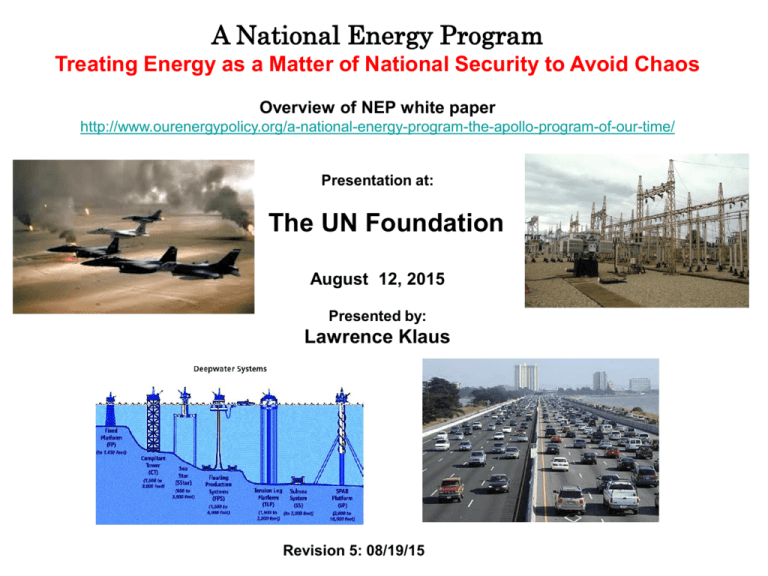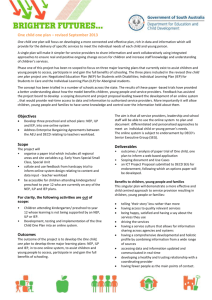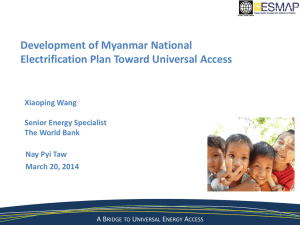A National Energy Program What, Why, When and How? Overview
advertisement

A National Energy Program Treating Energy as a Matter of National Security to Avoid Chaos Overview of NEP white paper http://www.ourenergypolicy.org/a-national-energy-program-the-apollo-program-of-our-time/ Presentation at: The UN Foundation August 12, 2015 Presented by: Lawrence Klaus Revision 5: 08/19/15 Presentation Outline • What Is The Goal • When Will We Achieve it? • Why Should We Achieve the Goal? To Avoid Chaos • How Will We Achieve the Goal? Use Methods Proven “At Scale” • How Will NEP Operate? • How Do We Start? NEP Planning Project • How Will We Educate Leaders Able To Solve Today’s Problems? 2 “What” Is The Goal: “When” Will We Achieve it? • To eliminate the gap between U.S. oil consumption and production and reduce green house gas emissions in a decade as a milestone on the road to a sustainable energy future. – Six million barrels of oil a day - High end of EIA, IEA forecasts for 2025 • Natural gas plentiful. Eliminating the “oil gap” = energy independence – 1,300 million metric tons of CO2 equivalent by 2025 • Goal and timeline set by Barak Obama and Xi Jinping at APEC summit – Oil, emissions timelines made coterminous to facilitate joint planning • It’s not just about us! – Our security and stability is becoming inextricably linked to security and stability elsewhere in the world - DOD 2013 National Security Strategy – America must lead by example to induce other energy consuming nations to become less dependent on energy from unstable and unfriendly nations • Use methods proven “at scale” – “Apollo like” program planning and management to achieve goal – Supply chains built during program position U.S. for sustainable future – NEP planning project prepares a NEP plan available in time to impact new administration coming into office – Methods used in national security matters 3 The Goal is a “Milestone” on the Road to a Sustainable Future NEP isn’t a “one shot deal” like Apollo • • • Reliance on fossil fuel is fueling our environmental demise Must start down road to reduce carbon loading of atmosphere faster Additional use of fossil fuel during “NEP decade” must be emissions neutral Oil gap and Emissions Reduction >= 6 0 Energy Products, Efficiency and Supply Chains MBD >= 1300 MMT Oil Gap and Emissions 0 Years 10 Years 20 Years Time NEP isn’t a “Zero Sum” game Fossil fuel and green energy interests make tradeoffs during planning process to resolve differences and secure buy in. 4 Projected Oil Gap 4-7 MBD in 2025 – IEA,EIA Business as usual forecasts oblivious of world events • Risk of supply disruptions, energy crises, conflicts not considered – Velocity in instability is ever increasing around the world - General Raymond Odierno, Army Times • Set goal at higher end (“at least” 6 MBD) to cover “downside risk” – Oil gap, emissions objectives and timeline set as floor not ceiling U.S dependence on imported liquids depends on both supply and demand 5 Source: EIA annual energy outlook 2013 Short Term Energy Euphoria Ignores Long Term Reality US and global weak demand and low gas prices reflects unstable conditions, deflationary pressures and rout in commodities Euphoria More oil produced at home than we buy from the rest of the world – the first time that’s happened in nearly 20 years … The all-of-the-above energy strategy I announced a few years ago is working, and today, America is closer to energy independence than we’ve been in decades - President Barak Obama, 2014 State of the Union Address Reality IEA, EIA forecast U.S. oil production will peak by 2020 then decline without achieving energy independence. Frontload activity to avoid being overtaken by unforeseen events again IEA Forecast of US Oil Production, 2012 EIA Early Release Annual Energy Outlook, 201 6 Global Production Won’t Eliminate the Oil Gap Global energy demand projected to increase one third from 2011-2035 - IEA WEO 2013 World’s major oil companies all suffer from some version of the same problem: spending more money to produce less oil. The world’s cheap, easy-to-find reserves are basically gone; the low-hanging fruit was picked decades ago. The new stuff is harder to find, the older stuff is running out faster and faster. - Bloomberg Businessweek, “Big Oil Has Big Problems” Costly Quest Exxon, Shell and Chevron have been spending at record levels as they seek to boost their oil and gas output. It has yet to pay off. Below, change in production since 2009 Source: the companies, reflects company 2013 estimates. - WSJ If global economy doesn’t revive, oil glut will be least of our problems 7 Why Should America Achieve the Goal? Must treat energy as a matter of national security to avoid chaos • “Arc of instability” from North Africa to Southeast Asia [the region] could become an “arc of chaos” involving forces of many nations - DOD 2010 Joint Operating Environment Report – Seven of top ten nations with largest oil and gas reserves in the region - EIA – We have a losing record in conflict in the region since WWII – Implications for future combat are ominous, should nations see the need to militarily secure energy resources - JOE 2010 • As our armed forces grow smaller, withdraw to the periphery and “pivot to Asia” our ability to defend the oil supply diminishes accordingly – Countries with high performance weapons develop capabilities to deny access into their countries and theater energy supplies [A2/AD] - JOE 2010 – While the armed forces will grow smaller, it is less likely their operational tempo will decrease - Capstone Concept for Joint Operations: Joint Force 2020, Joint Chiefs of Staff • Relationships between non-state and state actors provide numerous benefits to both - Terrorist-Criminal Pipelines and Criminalized States: Emerging Alliances, NDU – Eliminate oil addiction to drain money from states and non-state actors they support and threats will diminish accordingly 8 We Can No Longer Consider The Oil Fields Safe Where an increase in terrorist activity intersects energy supplies the need for immediate action may require significant conventional capabilities - JOE 2010 Future Stability Of Saudi Arabia Not Assured. If proxy wars turn into regional war key energy facilities impacting oil market and global stability will be at risk. Saudis trying to finish new border fence and then slam shut the gates as Yemen collapses - Reuters ISIL fighters set Iraq's Beiji oil refinery ablaze - Al Jazeera Fire at Libya’s biggest oil terminal destroys 1.8 million barrels of oil - Reuters ISIL blamed for new strikes aimed at crippling Libya oil production, rather than capturing it - WSJ What has to blow up before our leaders get it? 9 Power Shifts to Energy Producers With Different Interests Europeans invading Russia have frozen in the dark • E.U. imports about 30% of its crude oil, gas and hard coal from Russia – – – – – - Eurostat Countries closer to Russia’s border import energy at a much higher rates Lifting ban on U.S. oil exports doesn’t help Eastern European countries decrease reliance without building pipelines from ports to refineries - Reuters Russia’s strategy of buying up European oil refineries could compromise the bloc’s energy security [and ours] - EurActiv.com Mismatch between requirements of the world’s consumers and refineries’ capabilities US sends diesel to Europe. Europe sends gasoline to US - Global Refining Capacity, The Oil Drum Gas supplied by Russia Percent of total 2012 Source: Eurogas Some European nations import 80-90% of their energy needs from Russia 10 Control of Pipelines Shifts Power to Nations with Different Interests Russia divides to conquer • Greece and Russia sign MOU extending planned Turk Stream pipeline to Europe through Greece, with financing from Russia - Bloomberg.com South Stream and Nabucco gas pipelines Turk Stream to bypass Ukraine South Stream won competition with EU and American supported Nabucco. EU changed the rules Russia to halt gas shipments across Ukraine to Europe when transit contract ends in 2019 - Bloomberg.com Russians building Kerch Strait bridge Gazprom to build new Nord Stream-2 gas pipeline under Baltic Sea to Germany by 2020 with E.ON (Germany’s largest utility), Shell, OMV. - Reuters E.ON argues that Europe's demand for Russian gas will grow as domestic production declines to 185 BCM by 2030 from 275 BCM in 2010 11 Is America’s “Pivot to Asia” really a Pivot to a New Energy War? China rapidly expanding offshore oil fleet – adding coast guard vessels to protect it – as it ventures farther into the sea, threatening more altercations with neighbors - WSJ China’s “Nine-Dash” chart not in accord with UNCLOS US should sign this treaty to be credible Chinese coast guard vessels protecting oil rig ram Vietnamese vessel in disputed waters in South China Sea Dispute over territorial boundaries defining drilling rights. Mature network of military facilities would extend China’s ability to project power by over 800 kilometers Sea floor thought to be repository of large oil and gas deposits in contention by nations in region 12 Must Treat Energy as a Matter of National Security to Avoid Chaos Implications for future combat are ominous, should nations see the need to militarily secure energy resources - JOE 2010 Force won’t change conditions – competent American leadership will Force • Stumble into war trying to cut China off from energy in the China Seas – Growing tensions in the East and South China Seas have raised the risk of a “miscalculation” spilling over into a regional conflict – China encirclement could spark war, The Diplomat Leadership • U.S. works with China and Asia/Pacific nations to secure adequate energy sources and reduce demand to avoid a new energy war – – – – Every barrel of oil equivalent produced in America that is sent to Asia/Pacific, is a barrel we won’t have to defend or fight over with China China net oil imports will rise from 6.3 MBD in 2013 to 9.2 MBD in 2020 - Forbes China used 170 BCM of gas in 2013 will use 400- 420 BCM in 2020 - Fortune 83% of global energy demand growth in non-OECD countries - EIA The U.S. must take care not to repeat in its China policy the pattern of conflicts entered into with vast public support and broad goals but ended when the American political process insisted on a strategy of extrication that amounted to abandonment, if not complete reversal of the country’s proclaimed objectives… - “The Future of U.S.-Chinese Relations, Conflict is a Choice, Not a Necessity”, Henry Kissinger, Foreign Affairs 13 How Will We Achieve The Goal? Use Methods Proven “At Scale” • “Apollo like” program planning and management achieves the goal – – Replace oil from other sources by at least 6 MBD Eliminate 1,300 million tons of CO2 equivalent - Goal set by President Obama at APEC summit • Supply chains place U.S. on road to a sustainable energy future – • Achieving the goal is a “takeoff “point to achieve longer term goals by mid-century Long term planning replaces short term thinking – – Stop making it up as we go along, chasing rosy scenarios being blindsided by unforeseen events NEP planning project prepares plan for next administration as it comes into office The basic principles of strategy are so simple that a child may understand them. But to determine their proper application to a given situation requires the hardest kind of work from the finest staff officers. This planning meant the toilsome drudgery of grinding countless unrelated facts into homogenous substance. - Dwight D. Eisenhower, Crusade in Europe 14 Start by Ending Project/Program Confusion President Obama mentioned “funding the Apollo projects of our time” in energy. He then mentioned electric cars and passenger rail in the same breath as Apollo as though all were projects. - 2010 State of the Union message Apollo wasn’t a project. It was a program. • Programs achieve “ends” - goals and objectives – • Projects - “means” achieve ends – • Ends must be defined and agreed upon FIRST (go to the moon, build a national highway system, achieve energy independence) Means then defined and ranked in achieving goals and objectives (Keystone Pipeline, cap and trade, electric cars, passenger rail, etc.) Placing means before ends = Gridlock since 1973 OPEC Oil Embargo – – Can’t see forest for the trees Each interest hugs its tree and “fights below the tree line” to cut down trees of opposing interests Perfection of means and confusion of ends seem to characterize our age - Albert Einstein 15 “Apollo like” Program Planning and Management Method to define and achieve goals and objectives from inception to completion • The President defines a goal and timeline – • Goal in white paper used for planning is “placeholder” for goal set by next President Objectives/work elements defined to achieve goal by economic sector designed to meet stakeholder expectations. – Economic sector profiles developed and used as baselines for planning • Means (assemblies, tasks, projects) to achieve the goal are defined in tiers “down and across” objectives using a work breakdown structure (WBS) • Means are related to performing organizations using an organization breakdown structure (OBS) • Public/private finance sources/organizations are defined for each means using a financial breakdown structure (FBS) – – FBS unique to NEP which differs from publicly funded DOD programs Government “co-invests” to fill gap between business and needed investment • A cost/schedule system is developed to manage all work elements and means • The above are structured within a management framework wherein a change in any element immediately translates into impacts on all other elements 16 Approach Analogous to NASA Systems Engineering Engine - NASA Systems Engineering Handbook Replace Imported Oil and Reduce Emissions in Economic Sectors as Required to Achieve Goal Replace oil in economic sectors from other sources at least 6 MBD • Priority to sector objectives based on oil usage • Priority within sectors to means based on contribution to objective in a decade Energy Consumption by Sector and Energy Source, 2012 Source: DOE, EERE, Vehicles Technologies Office 18 Reduce GHG emissions in Economic Sectors at Least 1,300 MMT Achieve President Obama’s goal: GHG emission 26-28% below 2005 levels by 2025 • Priority to sector objectives based on potential emissions reduction • Priority within sectors to means based on contribution to objective in a decade Total U.S. Greenhouse Gas Emissions by Economic Sector in 2012 6,526 Million Metric Tons of CO2 equivalent Source: All emission estimates from the Inventory of U.S. Greenhouse Gas Emissions and Sinks: 1990-2012 19 Energy Efficiency Potentially Largest Source of Energy Production and Emissions Reduction • Rejected energy equal to 58.1% of energy used – – • - Lawrence Livermore National Laboratory Burdened cost of energy lost in process that does no productive work Priority to each sector based on potential to produce energy and reduce emissions DOD has overriding interest and capabilities; could take leadership role – – Waste reduction is life and death to military; dollars and cents to civilians U.S Army “Net Zero” Program covering waste, energy and water is a model for cross market development and proves it can be done 20 Proposed NEP Program Breakdown Structure White paper provides goal, objectives, scenarios and methodology “for discussion purposes” to begin NEP planning project Scenarios broken down to top level assemblies in white paper 21 Apollo PBS/OBS 22 NEP Isn’t a One Shot Deal Build Supply Chains for a Sustainable Energy Future Example: Transportation Sector Supply Chain • Transportation sector receives top priority based on oil usage – 70% of all the petroleum used in U.S. – 96% of energy used in the transportation sector is oil – Concentrate on motor vehicles - 59% of oil use in sector for light duty cars and trucks - Blue Print for Securing America’s Energy Future, US Chamber of Commerce – Other types may be included with support from related industries (Aircraft, Ships, Rail, etc) What is needed is an integrated, multi-pronged approach that cuts across Administrations and covers transportation fuels and vehicle - Fuel Choice for American Prosperity, Institute for the Analysis of Global Security 23 What is Supply Chain Management? • “Cradle to grave” planning, implementation and control of flow of information, materials, products and services from raw material to customer fulfillment and life cycle support and waste reduction/recycling • Supply chain work elements built “down and across” objectives Transportation Sector Vehicles Power and Fuels Sectors Customer/System Interface (Charging/Fueling Stations) Power/fuels 24 Planning Transportation Sector Supply Chains Priority to means in “rank order” to contribution to sector objective in a decade • Make “apples to apples” comparisons to prioritize each supply chain – • Gas: CNG uses existing gas production and distribution system – – – • Gas is “transition fuel” – plentiful, low cost, shorter term Need engine conversion, new fueling station network Reduces emissions by substituting less polluting means for oil Electricity: EV’s use existing power grid – – – – – • How Much, How Fast, How Clean, What Risk, What Cost? Electricity longer term requires extensive R,D&D Need “competitive” vehicle batteries, charging systems and fueling network “Buying new” costs more than conversion EV’s have range problem Eliminates emissions Liquids: Use existing vehicles and gas station network – – – – Alternatives “to” and “from” conventional fossil fuels (Biofuels, GTL, CTL) Need R&D, new plants, pipelines, freight transportation varies with fuel Methanol requires little change in existing system, but has range problem Emissions reduction varies by liquid • Hybrids: Transitional vehicles • Other: R,D&D continuous process to bring new technologies to market as they become commercially viable - NEP white paper 25 How Will NEP Operate? Public/Private Sector Partnership – Not Government Agency • Outside government, freed from political interference and earmarking – A Business Plan for America’s Future, American Energy Innovation Council – Managed by business and military professionals from stakeholder groups • Brings interests together to expedite R,D&D by means • Must provide real business opportunities, not government supported “Hobby Shops” to secure real business participation to achieve goal – Hobby Shop: 153,000 gas stations, 20,000 all other fuels in U.S. in 2015 - NGT News – Example of real business opportunity: Solve “chicken and egg” NGV problem • NEP brings fleet operators, oil/gas downstream operations, automotive, financial interests together to plan and finance conversion of economic number of vehicles (possibly one million trucks) to support building core national NGV fueling network • Fueling network to built by large energy producers • Existing gas station owners within network grid given opportunity to participate It wasn’t my job to tell industry how to do its job; it was our function to show industry what had to be done and then do everything in our power to enable industry to do it including stepping in if the marketplace couldn't deliver fast enough - Donald Nelson, Director of the War Production Board, Freedom’s Forge, Arthur Herman 26 How Will We Start? NEP Planning project • Produce a plan to impact next administration coming into office – – • “Plan B” for energy on separate track from our current track – gridlock – – • Planning of each objective by stakeholders involved in implementation • Stakeholders will have incentive to work with constituencies in Congress Options • Government project with assistance from industry, financial sector, universities, national laboratories • University or think tank project with assistance from government, industry, financial sector, national laboratories. President Roosevelt’s actions prior to Pearl Harbor an example • Saw danger and prepared for war on a separate track in a nation living in denial Hopefully, NEP won’t require another unforeseen calamity to be implemented • At a minimum, project will provide planning facility to deal with unforeseen events • Problems exist that require long term planning that are not be considered national security matters as yet Project has to start somewhere – NEP white paper presents a goal, objectives and implementation scenarios “for discussion purposes” to begin the project. When the evils that arise have been foreseen, they can be redressed, but when having not been foreseen, they are permitted to grow in a way that everyone can foresee them, there is no remedy - Niccolo Machiavelli, The Prince 27 NEP Planning Project: Coalition of the Willing Small team sets up project and recruits participants Stakeholders/participants in project provide funding and in-kind services Whitewashing the fence Short list of skill sets for NEP planning project • • • • • • • • • • • • • Illustration from Tom Sawyer Courtesy The Mark Twain House, Hartford • • Supply Chain Management and Logistics (military, civilian) Program and project management (military, NASA, aerospace) Investment , Commercial banks, Public finance Energy business and finance Accounting Coal, Oil and Gas industries (strategic planning and operations) Conventional and alternative automotive industries Industrial processes equipment and energy systems Residential, Commercial and industrial buildings energy systems Utility transmission, distribution systems and regulation Highways Solar, Wind, distributed generation Environmental management, engineering, impact mitigation Environmental and regulatory law Universities and think tanks with relevant departments “We have found that it is most effective and efficient for us to focus our efforts on established organizations, such as think tanks, universities, business associations, and bipartisan policy groups” 28 - Email from William M. Colton, Vice President, Corporate Strategic Planning, Exxon Mobil Corporation How Will We Educate Leaders of the Future? Integrate Planning and Operations Studies into Public Policy Education • Education – Teach “hard skills” not taught in public policy programs to enable students to become competent leaders in today’s increasing demanding environment • Comparative public, private, military organization; systems engineering; program and project planning and management; supply chain management and logistics; infrastructure economics; management information systems; accounting, finance, etc. – Courses not found at one institution: integrate courses at multiple institutions • Projects – Center for developing plans and programs in national interest – Students work on real world projects, gain experience, build relationships • NEP planning first project • Civilian/military interaction in classroom and projects builds understanding/ cooperation • Research and Development – Develop courses, seminars, briefings and documents to support education program and inform national discourse – Students participate in R&D What we do here will only be taught in professional and technical schools - Dwight D. Eisenhower, Crusade in Europe Ike didn’t leave a, Strategic Planning for Dummies” book, apparently - General Ronald Keys, USAF (retired) 29 Lawrence Klaus began his career as an architect in the offices of Emery Roth & Sons working on projects including working drawings for the World Trade Center. As a research engineer in the Boeing Aerospace Group (ASG) he designed and implemented automated business systems concerned with the design, manufacture, test, delivery, and installation of major military missile, space, and associated programs. He also participated in internal business planning to define ASG program management and information systems capabilities with civilian applications. At Peat Marwick Mitchell (now KPMG) he designed PPB and management and reporting systems for federal government agencies. This included projects such as design of a program planning system for regional plans for the Public Health Service. He founded and was president of Development Management Consultants Inc. and planned and managed company operations on dozens of projects working with utilities, lenders, contractors, non-profit organizations and government. This work included projects such managing local and federal disaster rapid emergency mass home repair. As a manager in the network systems group of Unisys Corporation he worked with company engineers to design networked PC to mainframe systems that integrated company and vendor software and hardware. This included projects such as the user friendly IDEAS online education system for the Air National Guard. As a consultant at Synergic Resources Corporation (now Navigant Consulting) he worked on energy efficiency projects for utilities such as MidAmerican Energy. As an independent consultant has worked on projects related to energy policy, networks and distributed generation. Mr. Klaus holds a B.S, Bachelor of Architecture and M.B.A. from the City College of New York. Contact Information Lawrence Klaus 651 E Township Line RD #2121 Blue Bell, PA 19422 Phone: 610-631-2190 Cell: 610-247-3363 Email: larryklaus1@gmail.com 30







